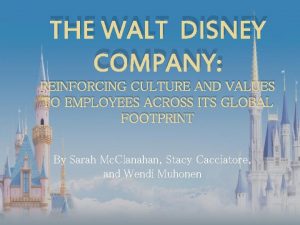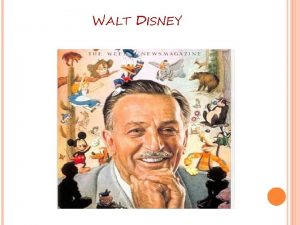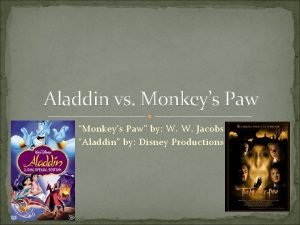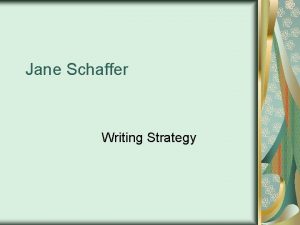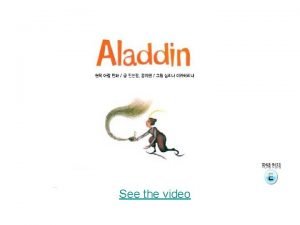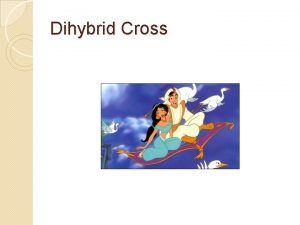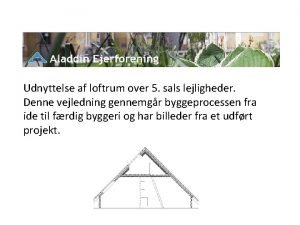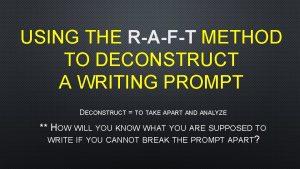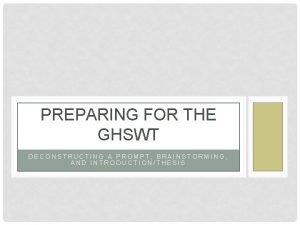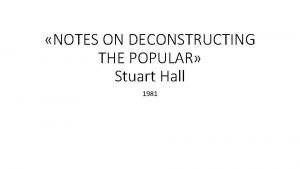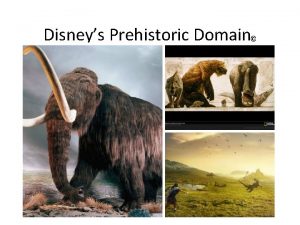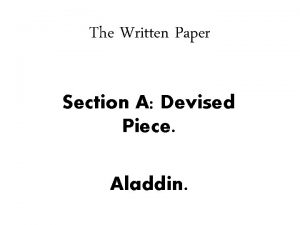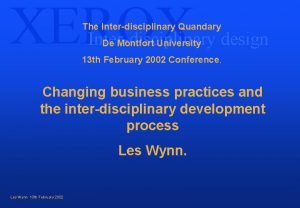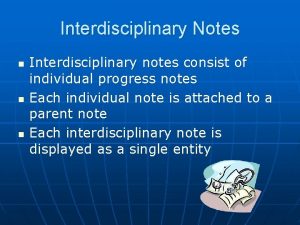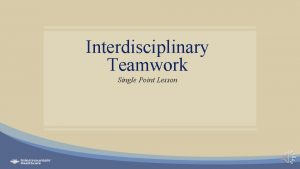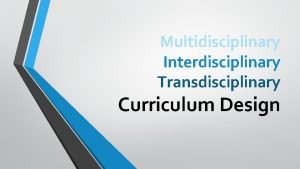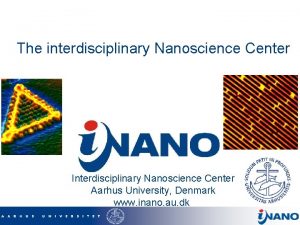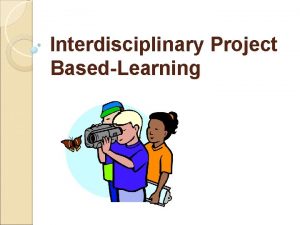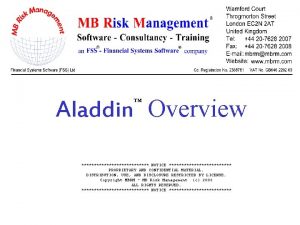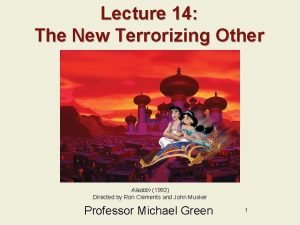Paper Proposal Deconstructing Disneys Aladdin Mrs Kordik Interdisciplinary

















- Slides: 17

Paper Proposal Deconstructing Disney’s Aladdin Mrs. Kordik Interdisciplinary Writing

Research Question n What stereotypes about the Middle East do children learn from the media?

Proposed Thesis American media aimed at children, such as Disney’s Aladdin, indirectly teaches children that the Arabic world is treacherous, exotic, supernatural, villainous, and inhumane. This media only serves to further perpetuate negative depictions of Arabs.

Source Primary Source: Disney’s Aladdin Secondary Source: “Terrorists, Madmen, and Religious Fanatics” by Anissa Janine Wardi

Orientalism n Racist view defined as the absolute difference between the West (who is seen as “rational, developed, humane, superior”) and the Orient (who is seen as “aberrant [not normal], undeveloped, inferior”) (Wardi 31) This means that there are large groups of people who believe that western culture is superior to eastern culture.

The Lyrics “Oh I come from a land, from a faraway place Where the caravan camels roam Where they cut off your ear If they don't like your face It's barbaric, but hey, it's home” - “Arabian Nights” “The narrative of Arab violence is established in the film’s opening song, which is overtly Orientalist” (Wardi 34)

“Everything about the man just plain impresses…And I absolutely love the way he dresses!” “Prince Ali” My observation: Alladin is dressed in this scene in Arab attire, which Jasmine disdains. “He's got ninety-five white Persian monkeys (He's got the monkeys, let's see the monkeys) And to view them he charges no fee (He's generous, so generous) He's got slaves, he's got servants and flunkies (Proud to work for him) They bow to his whim love serving him They're just lousy with loyalty to Ali! Prince Ali!” My observation: Is this what an Arab prince has? Isn’t this somewhat stereotypical? And all the Arab women are supposed to fawn over him, but Jasmine doesn’t. She wants a different kind of man—does that mean a western man?

“A Whole New World” (note: America used to be called the “New World. ” Is this actually a song about escaping to America? ) “I can show you the world Shining, shimmering, splendid Tell me, princess, now when did You last let your heart decide? ” My observation: Because in the Arab world, her father makes her decisions? “A whole new world A dazzling place I never knew But when I'm way up here It's crystal clear That now I'm in a whole new world with you” My observation: They have to literally escape their current Arabic world.

According to Wardi n In Orientalist theory, “The body of an Arab man is reduced to the symbolic embodiment of evil: the bloodthirsty madman/terrorist…Demonizing Arabs as monsters conveys the message that they should be feared as dangerous and violent creatures” (Wardi 32).

The Villains My observations: Jafar and his goons embody the evil “madmen” of which Wardi speaks. They have Dark skin Accents Sharp, severe facial features Dark facial hair Intense and furrowed eyebrows Are these physical Arabic qualities supposed to = bad guy?

The Sultan “Princess Jasmine is virtually imprisoned in her father’s castle” (Wardi 34). Arab men are “constructed as…patriarchal oppressors and cruel fathers” (Wardi 33). My observations: The Sultan has an accent and sharp nose, like the villains. Even though his white facial hair symbolizes “good, ” he still keeps Princess Jasmine locked in her home and forces her to marry. This is seen as the opposite of what she wants, showing the brutality of the patriarchal family.

Jasmine and Aladdin “Aladdin and Princess Jasmine are portrayed as anomalies in this backward, violent country. Unlike the rest of the characters, they speak with American accents and have light skin. They are in fact the literal embodiment of the West, and thus, easily lend themselves to being the heroes of the drama for an American audience” (Wardi 34). My observation: They look Western in contrast with the villains. • Lighter skin • Soft, rounded noses (Western) • No facial hair or severe eyebrows.

The Animal Buddies “The symbol of the tiger serves a two-fold purpose: (1) it adds to the exotic ambiance of the Middle East and (2) it is used as a measure of Arab humanity, implying as it does that animals are more trustworthy and compassionate than Arab people” (Wardi 34).

My observation: These “Westerners” can’t relate to the other Arabs in this world, so they turn to Abu and Raja for comfort. Because these animals don’t speak, they are non-threatening friends, whereas everyone else is out to hurt Jasmine and Aladdin.

My observation: The Genie also falls into this category of friends. He’s not actually human, so he’s their spiritual guide (and savior who helps them get out of this place). He may seem Arabic, but: no accent blue skin color—transcends race because he’s not racialized dark facial hair, like villains, but rounded features and small eyebrows

My observation: the Magic Carpet serves the same purpose as the Genie and animal friends. It has a suggestive Middle Eastern quality, it is given animal-like features, like a pet, and it helps Jasmine and Aladdin “escape” to a “whole new world. ” All of this supports Wardi’s theory that the heroes’ non-human friends are portrayed as more human the Arabic people they encounter.

Works Cited Aladdin. Dir. Ron Clements and John Musker. Perf. Robin Williams, Scott Weigner, Linda Larkin. Disney, 1992. DVD. Wardi, Anissa J. "Terrorists, Madmen, and Religious Fanatics: Revisiting Orientalism and Racist Rhetoric. " Race, Rhetoric, and Composition (1999): 31 -43. Western Washington University. Web. 7 Feb. 2010. <http: //www. ac. wwu. edu/~stevens 5/Course s/371/Wardi, %20 Terrorists. pdf>.
 Aladdin proposal
Aladdin proposal Disney company vision
Disney company vision Walt disneys childhood
Walt disneys childhood Jasmine and aladdin
Jasmine and aladdin Aladdins monkey
Aladdins monkey Schaffer paragraph structure
Schaffer paragraph structure Genie
Genie Aladdin bird name
Aladdin bird name Aladdin and jasmine
Aladdin and jasmine Udnyttelse af loftsrum
Udnyttelse af loftsrum Aladdin pellet stove
Aladdin pellet stove They are mrs garcia and mrs castro
They are mrs garcia and mrs castro Mrs. darling was ___________ of mrs. s.
Mrs. darling was ___________ of mrs. s. They are mrs garcia and mrs castro
They are mrs garcia and mrs castro What does raft stand for
What does raft stand for Deconstructing a prompt
Deconstructing a prompt Deconstructing standards
Deconstructing standards Stuart hall definition of popular culture
Stuart hall definition of popular culture

